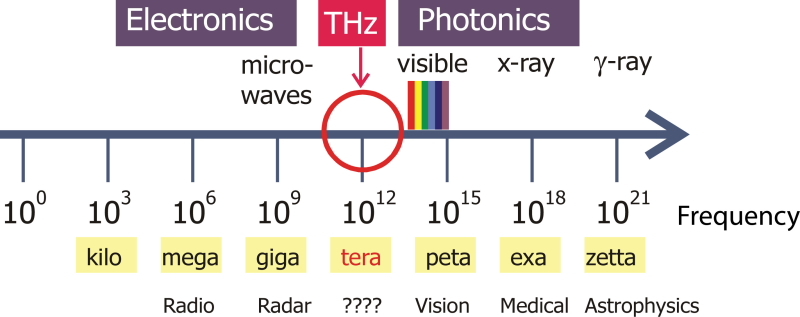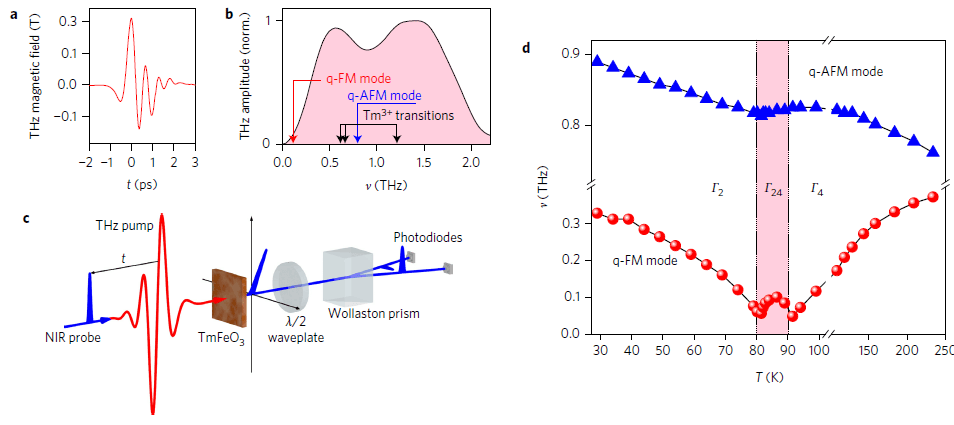Magnetic memory of the future. Terahertz radiation used for ultra-fast rewriting of spins

Superfast control of the magnetization of materials is the cornerstone of modern photonics. In the future, such technologies may find application in optical computers and terahertz electronics. In recent years, a number of successful experiments in this field have been made. Among them, the change in spin in antiferromagnets under the influence of light in a few picoseconds , the control of the oscillations of the magnetic moments of an antiferromagnet by a pair of femtosecond lasers , the phase transition from a ferromagnet to an antiferromagnet under the influence of light during femtoseconds, and others. Despite the remarkable progress in this area, more Light energy is not directly involved in the interaction of light with a magnetized material. This means that, in practice, significant energy diversion efforts will be required.
The team of Dutch, German and Russian scientists from the Institute of General Physics. Prokhorov RAS, Moscow Technological University (MIREA) and MIPT have developed a much more efficient and practical way to superfast control of the magnetization of the material. Instead of visible and infrared light, they used electromagnetic pulses of terahertz radiation. Thus, scientists propose to use not laser pulses but T-rays to rewrite information in the computer memory of the future.
Terahertz radiation is a type of electromagnetic radiation whose frequency spectrum is located between the infrared and microwave ranges with a wavelength from 1 to 0.1 mm. T-rays easily pass through most dielectrics, but are well reflected by conductive materials (metals) and are absorbed by many liquids (water).
')
Experiments on controlling magnetization using terahertz pulses were carried out before, but other interaction mechanisms were involved there. Russian physicists have proposed a conceptually new universal mechanism.
The fact is that the strength and direction of magnetic anisotropy in almost all materials is determined by the pairing of the orbital states of electrons with ordered spin states. Consequently, an ultrashort electric field pulse that drastically changes the orbital states of the electrons can lead to a sudden change in the magnetic anisotropy. Scientists have assembled an experimental setup and tested the theory that a change in magnetic anisotropy leads to magnon oscillations with large amplitudes, which quadratically depend on the strength of the terahertz field.
Magnon is a quasi-particle corresponding to the elementary excitation of a system of interacting spins. Such an individual particle does not actually exist by itself, but the use of such a concept greatly simplifies the description of the process that actually takes place at the quantum level.
The authors of the scientific paper write that in the terahertz spectral range this concept (controlled change in magnetic anisotropy and magnetization) can be applied to any material in which changes in electronic orbitals lead to a change in magnetic anisotropy. For example, these are different oxides with 3d and 4f ions. Among them are various orthoferrites, manganites and ferroborates, as well as various compounds with 3d ions, such as hematite α-Fe 2 O 3
Prior to the Russian-German experiment, similar properties of terahertz radiation remained, by and large, unexplored.
The fundamental idea is shown in the illustration. For the experiment, an antiferromagnet TmFeO 3 —thulium orthoferrite was used. This material crystallizes in the deformed perovskite structure.

The experiment showed that the T-ray beams very effectively in terms of energy consumption change the magnetic properties of both iron ions and thulium ions.

“We made an important step towards terahertz electronics: we showed a qualitatively new approach to controlling magnetization using short pulses of terahertz radiation. As far as we know, our work is the first example of such an application of T-rays, ” said Anatoly Zvezdin from the Moscow Institute of Physics and Technology in Dolgoprudny.
According to experts, it is appropriate to use terahertz radiation in optical computers for ultrahigh-speed transmission of information, recording information on magnetic media, etc. In addition, T-rays can be used to monitor the work of living cells in real time and many other purposes.
Anatoly Zvezdin noted that these experiments are a continuation of the research that Soviet scientists conducted at Moscow State University: “In the USSR, a group at Moscow State University investigated orthoferrites, and we had a priority in this area. In a sense, our work is a continuation of those studies, ”he said.
The scientific work was published on October 3, 2016 in the journal Nature (doi: 10.1038 / nphoton.2016.181).
Source: https://habr.com/ru/post/372761/
All Articles